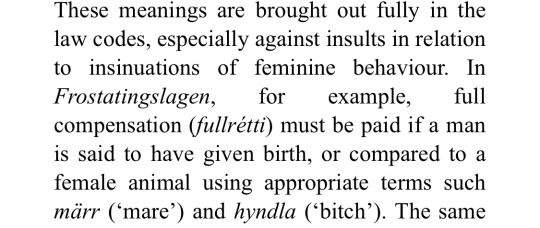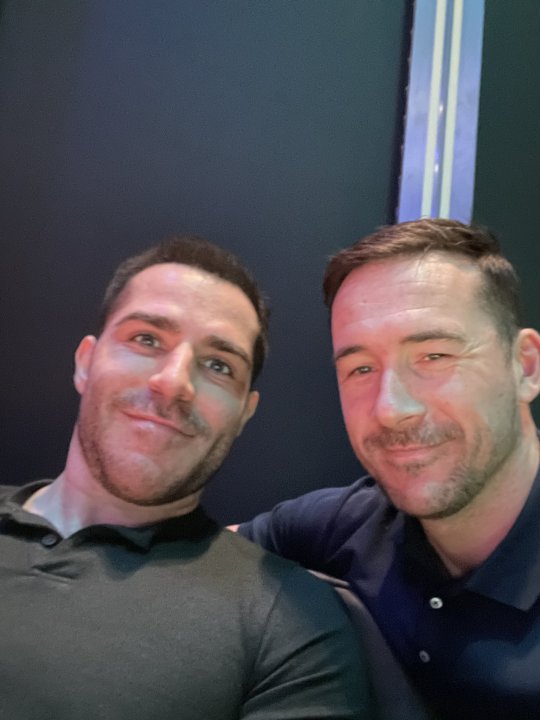#Neil price
Text
Book Review of 'A History of the Vikings: Children of Ash and Elm' by Neil Price

This is probably singlehandedly one of the best academic books I've read as a pagan addressing the Viking era and its people's.
The author did a PHENOMENAL job of using academic sources (archaeology, literature, historical linguistics, etc) to really paint a living picture of the peoples being discussed in their entirety. The author left room for the peoples spiritual/supernatural believes that I don't often see done by writers who are not writing specifically for a pagan audience.
It was deeply refreshing and I sincerely hope to see more academic authors following in their footsteps in the years to come
#pagan#paganism#paganblr#norse#norse paganism#norse polytheism#scandinavian#Scandinavian paganism#Scandinavian polytheism#vikings#viking era#book#books#book review#Neil Price#children of ash and elm#blackcrowing
91 notes
·
View notes
Text
Strangely, Asgard also contained temples, cult buildings where the gods themselves made offerings—but to what or whom? The mythology of the Vikings is one of only a tiny handful in all world cultures in which the divinities also practised religion. It suggests something behind and beyond them, older and opaque, and not necessarily ‘Indo-European’ at all. There is no indication that the people of the Viking Age knew what it was any more than we do.
Neil Price, Children of Ash and Elm
#book quotes#children of ash and elm#norse mythology#vikings#norse#viking history#books and libraries#literature#books and reading#Neil price
72 notes
·
View notes
Text

this is like poetry to me
24 notes
·
View notes
Text
"In a literal sense, the Vikings are of course people of the past, dead and gone—but at the same time they inhabit a curiously haptic kind of prehistory, one that appears to return whatever pressure is applied to it. Many have been tempted to put their fingers on the scales of hindsight and imagined that the impulse to do so came not from themselves but through the revelation of hidden truths buried by time. Medieval monks and scholars reinvented their pagan ancestors either as nobly misguided forebears or as agents of the devil. In the manuscript illuminations of Romance literature, with a kind of Orientalist prejudice, they became Saracens, enemies of Christ depicted with turbans and scimitars. In Shakespeare’s England, the Vikings were taken up as violent catalysts in the early story of the kingdom’s greatness. Rediscovered during the Enlightenment as a sort of ‘noble savage’, the figure of the Viking was enthusiastically adopted by the nationalist Romantics of the eighteenth and nineteenth centuries. Searching for their own emerging identities, Victorian imperialists scoured Scandinavian literature looking for suitably assertive northern role models, expressing the manifest destiny of the Anglo-Saxons through their Nordic cousins. The logical end of that trajectory came a century later, when the Nazis appropriated the Vikings in pursuit of their racist fictions, elevating them as a spurious Aryan archetype; their modern successors still plague us today. Elements of the broad Pagan community now seek a spiritual alternative that draws inspiration from Viking religion, with Tolkienesque flavourings added to a cloudier Old Norse brew. All these and many more, including today’s academics and the audiences for historical drama, have taken the fragmentary material and textual remains of the Vikings and recast them in moulds of their choosing. At times it can seem that the actual people have almost disappeared under the cumulative freight they have been made to bear."
- Neil Price, “Children of Ash and Elm: A History of the Vikings”
#history#norse history#vikings#viking age#viking history#neil price#children of ash and elm#this was a phenomenally detailed and comprehensive book#queue#mine
44 notes
·
View notes
Text



— Neil Price, Children of Ash and Elm
6 notes
·
View notes
Text



The visual of the vikings suing each other over getting called a bitch is so funny to me
#vikings#history#ergi#this book is about viking magic and this section is about#how practicing seidr as a man was morally poluting feminizing and queering#but this part made me laugh#another viking draws a picturing of you getting fucked and the laws saws you can kill him about it skdhdnsknsns wild#nid#ancient norse#neil price
3 notes
·
View notes
Quote
The nine stone packings at Götavi also raise an important and recurring component of the Viking mind: the sacred number. Nine - and its square root, three - appears numerous times in the mythological tales of the Norse. The sea-deities Aegir and Rán have nine daughters, the spirits of the waves; Heimdall has nine mothers; the giant Baugi has nine thralls; the beautiful Menglod has nine attendants; Gróa has nine protective charms; Odin has eighteen spells - twice nine; Thrivaldi, another giant who is slain by Thor, has nine heads. Freyr waits for his lover and later wife, Gerthr, for nine nights, the same length of time that Odin hangs on the tree in self-sacrifice, and sweats between the fires in 'Grímnir's Sayings', and makes his long ride to Hel on Sleipnir. In Valhöll, on every ninth night eight rings drop from the great gold ring, Draupnir (thus making nine in all), the source of Odin's wealth. The Muspell princess Laegjárn has a chest that must be closed with nine locks, one by one. The list goes on and on, and is replicated in the human world of Midgard: according to Adam [of Bremen] the great sacrifices at Uppsala last for nine days and are held every nine years, and nine creatures of each kind are killed. (In assessing the veracity of Adam's text, by the way, one might ask how he could have invented just that little detail to fit so well with wider picture he could not have known about.)
Neil Price, from Chapter 7 of “The Children of Ash & Elm | A History of the Vikings”, Penguin Books, 2020
14 notes
·
View notes
Text


getting real emotional over this
4 notes
·
View notes
Text
The institution of slavery had long antecedents in Scandinavia, probably going back thousands of years before the time of the Vikings. By the eighth century, there was already a considerable population of unfree people living in the North, their condition being largely a hereditary one built up over generations. In the Viking Age, this picture changed dramatically because for the first time Scandinavians began to make the active acquisition of human chattel a key part of their economy. This was one of the primary objectives of the Viking raids and military campaigns, and the results was a massive increase in the numbers of enslaved people in Scandinavia.
Let it therefore be clearly stated: the Vikings were not only slavers, but the kidnapping, sale, and forced exploitation of human beings was always a central part of their culture.
Neil Price, Children of Ash and Elm
2 notes
·
View notes
Text
Cooking implements have been most often been found in the graves of male vikings. Make of that what you will.
2 notes
·
View notes
Text
Children of Ash and Elm - Neil Price

Summary: A history of the Viking Age grounded in archeology and material culture that attempts to get at the lived experience of the Vikings.
Quote: “The Viking mind is far away from us today, but occasionally just about tangible.”
My rating: 4.5/5.0 Goodreads: 4.18/5.0
Review: Price’s clear and evocative writing could make any subject interesting, but the mysterious and strange world of the Vikings doesn’t need a lot of help. The book is enormous, covering death rituals, trade patterns, violence, gender, and crafting, for a start. No matter the subject, Price presents fascinating detail on the archeology and textual evidence that allow scholars to make informed guesses on how the Vikings experienced their world. He attempts to sketch out not just their physical landscape, but their mental and emotional one as well, never straying too far from the rigorous standard of evidence he has set himself.
The audiobook, read by Samuel Roukin, is long but brilliant.
1 note
·
View note
Text

"...history is nothing if not a suppositional discipline, sometimes akin to a sort of speculative fiction of the past." - Neil Price
#A study post for people who's spaces aren't aesthetic#some of us are normal and only study at our very average houses#A history of the vikings: children of ash and elm#neil price#Yggdrasil#self esteem#studying#studyblr#aesthetic#aestheitcs#academic#academics
2 notes
·
View notes
Text
A strong sense of the numinous place courses through Norse poetry and even runic inscriptions, created by minds in tune with their environment. The same mind-set is visible in their material culture, in every available surface—including the human body—covered in interlaced designs, writhing patterns, animals, and other images that were imbued with meaning. Their world hummed with life, but its boundaries, both internal and external, were in many senses more permeable than ours, always and constantly connected by winding paths to the realms of the gods and other powers. —Neil Price, Children of Ash and Elm: A History of the Vikings
1 note
·
View note
Text
daddy issue? I LOVE DADDY ISSUES 🫶❤️




#simon riley x reader#samuel roukin#simon ghost riley#simon riley x you#ghost cod#simon ghost x reader#ghost imagine#ghost x reader#price x reader#john price#john price x reader#barry sloane#graves x reader#phillip graves#warren kole#soap mw2#soap x reader#soap cod#john soap mactavish#neil ellice
3K notes
·
View notes
Text
🙂🙂 🤨🤨


Price and his two sons teammates
#captain price#price#john price#soap#soap mactavish#john mactavish#john soap mactavish#kyle garrick#kyle gaz garrick#gaz#call of duty#call of duty modern warfare#call of duty mw2#cod#modern warfare#modern warfare 2#elliot knight#barry sloane#neil ellice
6K notes
·
View notes
Text

— Neil Price, Children of Ash and Elm
#excerpts#neil price#children of ash and elm#words#book quotes#quotes#norse history#norse mythology#on languages#linguistics
4 notes
·
View notes